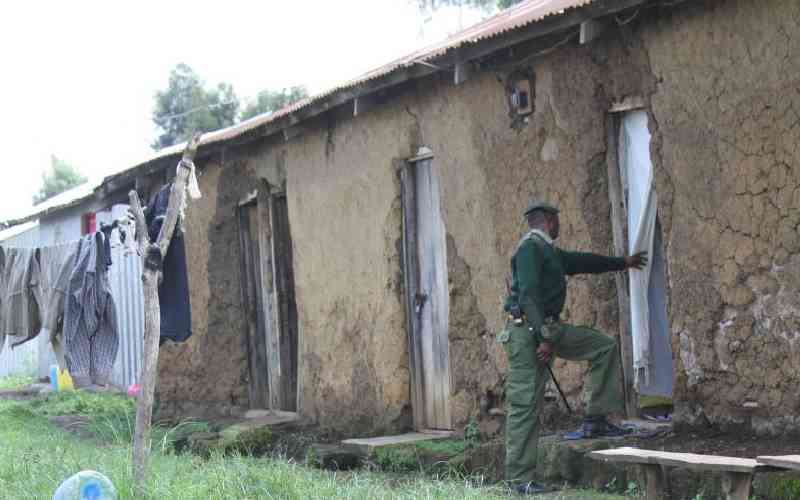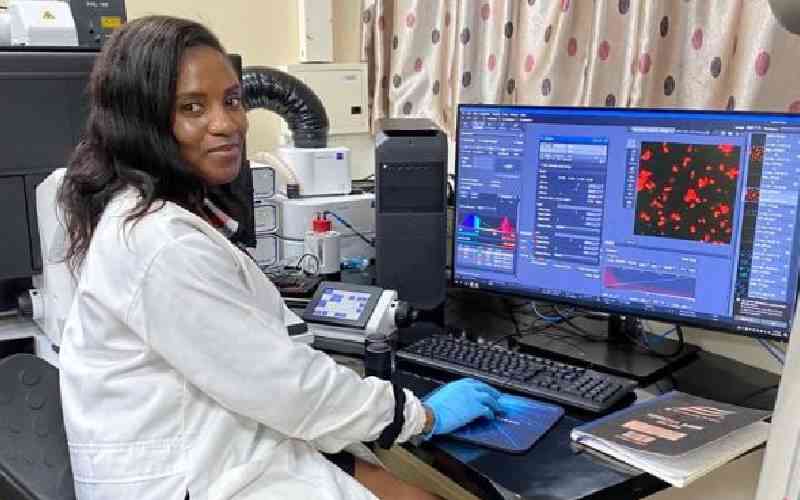Nairobi Remand Prison in Industrial Area is fabled as a dungeon which bubbles with all manner of criminals and social misfits.
There have been allegations ranging from smuggling cartels, rampant homosexuality to inmates being fed on pathetic diets and portions.
To prove or burst these lofty stories, Wednesday Life lifted the lid off this legendary remand facility and ventured deep inside its dark halls.
Once you go past the main gate, an old mahogany ever-locked door with a huge iron knocker ushers the visitor into the heavily-secured jailhouse.
Identification cards must be scrutinised and left in the custody of the warden on duty and those without identification documents cannot go past this point.
A special room at the corner serves as the meeting point where visitors speak to inmates. But given our mission here, the second heavy door leading inside the main prison blocks is swung open.
A huge complex compartmentalised by wire mesh and iron gates opens before us with hundreds of inmates engaged in various activities.
“Those ones there are petty offenders who have just been sentenced and are awaiting transfer to minimum security prisons,” Kimutai Too, Officer-in-Charge of the Remand Prison, explains pointing to a group of squatting inmates with his swagger cane.
“This remand prison houses more than 3,000 prisoners whose cases are ongoing in the courts. Once they have been sentenced they are transferred to other prisons where they will serve their terms”.
We negotiate a heavy metallic gate in this inside world and land in a yard at the end of which there is a row of buildings, with one of the doors bearing a plaque labeled “Computer Lab”.
The room is split into two sections with one area occupied by people seating in pairs.
“This is the counseling section where inmates afflicted by various issues are offered mental therapy by professional counselors,” Too says.
“The counselors are all volunteers who come in at specific days.”
The next room is cramped with five desktop computers, each occupied by an inmate busy working on a machine.
Walking from one student to the next issuing instructions and guidance is a dark middle-aged man who, although rugged by jail life, exudes knowledge and confidence.
Stay informed. Subscribe to our newsletter
“I graduated from Jomo Kenyatta University of Agriculture and Technology with a degree in computer technology. I worked in several major companies before I came here,” Kennedy Ondiek, the voluntary instructor explains.
“I was brought here several months ago after being accused of robbery with violence in my last posting as a security manager.”
The computer class trains twenty inmates per three- month “semester”. They go through seven packages then sit for exams and receive certificates issued by Zetech University which donated all the computers.
“I am glad for this programme because it gives me hope that when I get out of here, I can apply this knowledge for good and shun deviant behaviour. Before taking this class, I knew nothing about computers but now I am a very knowledgeable,” said one of the inmates who declined to give his name.
In the adjacent room there is a motivational session going on where inmates are dancing to some fast-paced tunes as they chant some slogans, all meant to lift their spirits.
“I come here every Wednesday and my main agenda is to engage the prisoners in sessions that give them hope and make them understand that being in prison is not the end of life,” says Mary Gacheru, a volunteer counselor.
“It is purely on a voluntary basis and I would like to urge other counselors and motivational speakers to find some time and talk to these inmates.”
Housed in the same block is a music class that has a piano and a fellow inmate taking the about-twenty prisoners through the keys.
Next is the prison art room where juvenile inmates are busy with crayons and pencil work. The art on display is a clear indicator of their emotions taking flight beyond the restricting prison walls.
Colourful crayon drawings titled “Prison will not break me”, “Let’s avoid crime” and “One day I Will be Free” don the walls.
“Learning to express myself through art, something I never did while outside, has been very liberating for me,” explains a 15-year-old boy who is here for attempted defilement.
“I am optimistic that one day when I get out these skills will be of benefit to me.
We find a crowd of prisoners gathered at the prison yard, their faces eager with expectation.
Before the warden could explain what is happening, a group of five young men clad in black t-shirts, tracksuits and sport shoes emerge to thunderous applause and proceed to dance to fast paced tunes.
With dyed and dreadlocked hair, bling on their neck and fingers and the swag and confidence of a dancing troupe, it is very hard for a stranger to believe that these are men behind bars.
The warden explains that inmates in remand do not work because they are yet to be convicted.
So, to keep them busy and ensure they have a channel through which to direct their energies, since most of them are young, the prison management allows them to engage in music and sports.
One of the artistes, Barnabas Odhiambo - a 21-year-old popularly known as Wrong Turn from Dandora said he discovered his talent at the facility.
“I was brought here five years ago after being accused of robbery with violence. My case is still ongoing and I am optimistic that I will get out here soon. I never thought I could dance and my plan, once I get out of here, is to use this new-found talent to earn a living and warn fellow youth against crime,” he said.
His sentiments are echoed by David Kireici “Latizzo” from Kibera who entertains his fellow inmates with his rapping prowess.
“Crime can never be the answer and the youth need to know that. We are here because we followed the wrong path,” explains Kireici who was arrested for robbery with violence.
“I believe one day I will be a free man. And when that day comes I will go out there and use my talent to spread the message of righteousness among the youth.”
Away from these activities and through more iron gates and wire compartments there is the K-Block which houses hardcore criminals.
The gate to this block is always locked, we are told, and hanging from the protective wire are several handcuffs.
Beyond this highly guarded unit is L-3 block where those suffering from HIV/AIDS are housed. Unlike many other blocks this room is very quiet and cold with many of the inmates lying in their beds wrapped in their blankets.
Contrary to the very active crowd at the jailhouse square, most of the prisoners here seemed dazed with unfocused gazes trained on the ceiling. Many are here for petty crimes such as assault and theft and are supervised by their fellow inmates.
“My work here is to ensure they take their medication at the right time because most are on ARVs,” says John Mutuku Kioko, the head prisoner.
“I also ensure that those affected by opportunistic infections are seen by the doctor or rushed to hospital as soon as possible.”
The section was established in 2008 to cater for ailing prisoners, mostly those that are brought while afflicted by HIV/AIDS and other diseases.
“Although all the people suffering from HIV/AIDS are placed in this room, there are other people who need special care like the disabled and suspects shot and injured by police at crime scenes,” explains Chief Inspector Johnston Musyoka, the warden in charge of L-3 Block and prison recreation.
“They are also the only people in this prison who sleep on beds. It is a privilege extended to them in a bid to improve their general wellbeing”.
The L-3 Block also helps avoid mixing those ailing with the rest of the inmates because of stigma and spread of infections.
As we come to an end of what has been an eye-opening time at this remand facility, Too tells us he is appreciative of ordinary Kenyans who give their time, by volunteering, saying this has a positive impact on inmates.
“We are however, still short-handed in some sections and need the intervention of more organisations and individuals.
“Donations like books to stock up our library and medication to help care for our sick inmates would be highly appreciated.
“We also need more volunteer counsellors because the need is still very great,” he says.
 The Standard Group Plc is a
multi-media organization with investments in media platforms spanning newspaper
print operations, television, radio broadcasting, digital and online services. The
Standard Group is recognized as a leading multi-media house in Kenya with a key
influence in matters of national and international interest.
The Standard Group Plc is a
multi-media organization with investments in media platforms spanning newspaper
print operations, television, radio broadcasting, digital and online services. The
Standard Group is recognized as a leading multi-media house in Kenya with a key
influence in matters of national and international interest.
 The Standard Group Plc is a
multi-media organization with investments in media platforms spanning newspaper
print operations, television, radio broadcasting, digital and online services. The
Standard Group is recognized as a leading multi-media house in Kenya with a key
influence in matters of national and international interest.
The Standard Group Plc is a
multi-media organization with investments in media platforms spanning newspaper
print operations, television, radio broadcasting, digital and online services. The
Standard Group is recognized as a leading multi-media house in Kenya with a key
influence in matters of national and international interest.









